A Chicago 2016 Reading List
President Barack Obama announced this morning that he is heading to Copenhagen later this week to put in the good word to the International Olympic Committee for his hometown of Chicago, which is competing with Rio, Madrid, and Tokyo to host the 2016 summer games. Meanwhile, Chicago is counting down to the announcement on Friday, which is expected at around 11:30 local time.
It’s an exciting week in the Windy City, as the Chicago 2016 bid committee wraps up years of campaigning (which included, as of late, appealing to morning commuters on CTA buses). But no matter what happens Friday, Chicago is undoubtedly a world-class city that deserves the attention and affection of the global community. So, in a last minute appeal to the IOC (who we are sure are loyal readers of The Chicago Blog), the Press presents a reading list that extols Chicago’s many virtues. Let friendship shine!
 Chicago’s motto is “Urbus en Horto,” or “City in a Garden.” And indeed, modern Chicago more than lives up to its name with an extensive park and beach system (covering more than 7,300 acres). To begin, any city naturalist would do well to check out Sally A. Kitt Chappell’s Chicago’s Urban Nature:A Guide to the City’s Architecture + Landscape. Packed with maps and recommended tours, and bursting with splendid photos, this is an essential guidebook for day-trippers, lifelong Chicago residents, and professionals in landscape architecture, urbanism, and design.
Chicago’s motto is “Urbus en Horto,” or “City in a Garden.” And indeed, modern Chicago more than lives up to its name with an extensive park and beach system (covering more than 7,300 acres). To begin, any city naturalist would do well to check out Sally A. Kitt Chappell’s Chicago’s Urban Nature:A Guide to the City’s Architecture + Landscape. Packed with maps and recommended tours, and bursting with splendid photos, this is an essential guidebook for day-trippers, lifelong Chicago residents, and professionals in landscape architecture, urbanism, and design.
 From there, we recommend taking a tour with naturalist Joel Greenberg. His A Natural History of the Chicago Region integrates historical anecdotes and episodes straight from the words of early settlers and naturalists with current scientific information, placing the natural history of the region in a human context, showing how it affects our everyday existence in even the most urbanized landscape of Chicago. (For a more irreverent take on urban nature, check out Jerry Sullivan’s Hunting for Frogs on Elston, and Other Tales from Field & Street. And for a more geographical perspective, we recommend John C Hudson’s Chicago: A Geography of the City and Its Region.)
From there, we recommend taking a tour with naturalist Joel Greenberg. His A Natural History of the Chicago Region integrates historical anecdotes and episodes straight from the words of early settlers and naturalists with current scientific information, placing the natural history of the region in a human context, showing how it affects our everyday existence in even the most urbanized landscape of Chicago. (For a more irreverent take on urban nature, check out Jerry Sullivan’s Hunting for Frogs on Elston, and Other Tales from Field & Street. And for a more geographical perspective, we recommend John C Hudson’s Chicago: A Geography of the City and Its Region.)
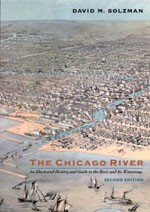 If it wins the games, Chicago will be constructing many new stadiums. But in the Chicago River, the city has a built-in venue for rowing and other water sports. David M. Solzman’s The Chicago River: An Illustrated History and Guide to the River and Its Waterways, Second Edition is an encyclopedic work—at once guidebook and history—that explores the river’s physical character and natural history.
If it wins the games, Chicago will be constructing many new stadiums. But in the Chicago River, the city has a built-in venue for rowing and other water sports. David M. Solzman’s The Chicago River: An Illustrated History and Guide to the River and Its Waterways, Second Edition is an encyclopedic work—at once guidebook and history—that explores the river’s physical character and natural history.
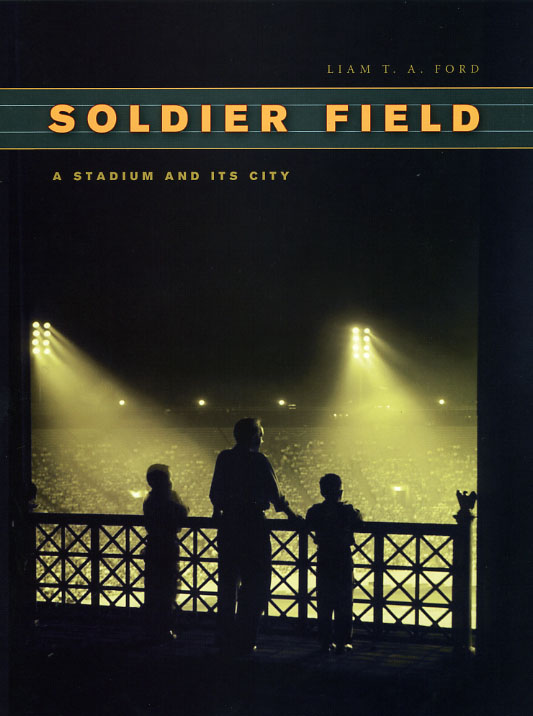 The Windy City is home to some of the country’s—and world’s—most iconic structures. A site of pilgrimage for many a football fan, Soldier Field is actually much more than a venue for gridiron grudge matches. Liam T. A. Ford explores the landmark’s origins and other uses in Soldier Field: A Stadium and Its City, recounting how this amphitheater evolved from a public war memorial into a majestic arena that helped define Chicago.
The Windy City is home to some of the country’s—and world’s—most iconic structures. A site of pilgrimage for many a football fan, Soldier Field is actually much more than a venue for gridiron grudge matches. Liam T. A. Ford explores the landmark’s origins and other uses in Soldier Field: A Stadium and Its City, recounting how this amphitheater evolved from a public war memorial into a majestic arena that helped define Chicago.
 The Chicago Tribune is one of the city’s two dailies, but its headquarters on North Michigan Avenue stands tallest as one of the most unusual buildings in town. The story of how it came to be is recounted in Katherine Solomonson’s The Chicago Tribune Tower Competition: Skyscraper Design and Cultural Change in the 1920s. In 1922, the Chicago Tribune sponsored an international competition to design its new corporate headquarters. Both a serious design contest and a brilliant publicity stunt, the competition received worldwide attention for the hundreds of submissions—from the sublime to the ridiculous—it garnered. In this lavishly illustrated book, Solomonson tells the fascinating story of the competition, the diverse architectural designs it attracted, and its lasting impact.
The Chicago Tribune is one of the city’s two dailies, but its headquarters on North Michigan Avenue stands tallest as one of the most unusual buildings in town. The story of how it came to be is recounted in Katherine Solomonson’s The Chicago Tribune Tower Competition: Skyscraper Design and Cultural Change in the 1920s. In 1922, the Chicago Tribune sponsored an international competition to design its new corporate headquarters. Both a serious design contest and a brilliant publicity stunt, the competition received worldwide attention for the hundreds of submissions—from the sublime to the ridiculous—it garnered. In this lavishly illustrated book, Solomonson tells the fascinating story of the competition, the diverse architectural designs it attracted, and its lasting impact.
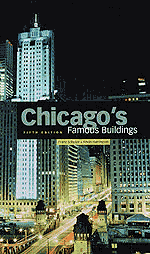 Chicago is home to many celebrated structures, and Franz Schulze and Kevin Harrington’s Chicago’s Famous Buildings catalogs all of the city’s architectural riches. From city’s classical legacy of Adler, Sullivan, Burnham, Root, Wright, and Mies van der Rohe to the massive reconstruction of Grant Park around Frank Gehry’s Music Pavilion, Schulze and Harrington cover it all, and with a glossary of architectural terms, an extensive index, and more than two hundred new photographs of both old and new buildings, it’s comprehensive and illustrative.
Chicago is home to many celebrated structures, and Franz Schulze and Kevin Harrington’s Chicago’s Famous Buildings catalogs all of the city’s architectural riches. From city’s classical legacy of Adler, Sullivan, Burnham, Root, Wright, and Mies van der Rohe to the massive reconstruction of Grant Park around Frank Gehry’s Music Pavilion, Schulze and Harrington cover it all, and with a glossary of architectural terms, an extensive index, and more than two hundred new photographs of both old and new buildings, it’s comprehensive and illustrative.
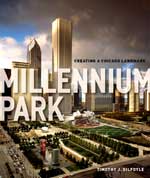 Speaking of Grant Park’s restoration, Millennium Park was at the center of those efforts, and the resulting public space has quickly become one of the city’s newest and most beloved treasures. Born out of civic idealism, raised in political controversy, and maturing into a symbol of the new Chicago, Millennium Park is truly a twenty-first-century landmark, and it now has the history it deserves in Timothy J. Gilfoyle’s Millennium Park: Creating a Chicago Landmark. Part park, part outdoor art museum, part cultural center, and part performance space, Millennium Park is now an unprecedented combination of distinctive architecture, monumental sculpture, and innovative landscaping.
Speaking of Grant Park’s restoration, Millennium Park was at the center of those efforts, and the resulting public space has quickly become one of the city’s newest and most beloved treasures. Born out of civic idealism, raised in political controversy, and maturing into a symbol of the new Chicago, Millennium Park is truly a twenty-first-century landmark, and it now has the history it deserves in Timothy J. Gilfoyle’s Millennium Park: Creating a Chicago Landmark. Part park, part outdoor art museum, part cultural center, and part performance space, Millennium Park is now an unprecedented combination of distinctive architecture, monumental sculpture, and innovative landscaping.
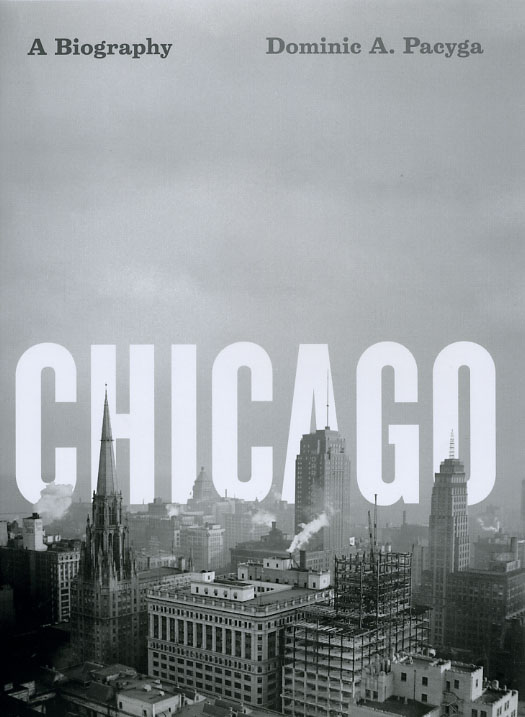 This city is many things to many people, but to Dominic A. Pacyga it is simply home. Chicago: A Biography is a magisterial account that both considers the famous—from Al Capone and Jane Addams to Mayor Richard J. Daley and President Barack Obama—to the not-so-famous—city’s steelyard workers and kill floor operators—and maps the neighborhoods distinguished not by Louis Sullivan masterworks, but by bungalows and corner taverns. Filled with the city’s one-of-a-kind characters and all of its defining moments, Chicago: A Biography is as big and boisterous as its namesake—and as ambitious as the men and women who built it.
This city is many things to many people, but to Dominic A. Pacyga it is simply home. Chicago: A Biography is a magisterial account that both considers the famous—from Al Capone and Jane Addams to Mayor Richard J. Daley and President Barack Obama—to the not-so-famous—city’s steelyard workers and kill floor operators—and maps the neighborhoods distinguished not by Louis Sullivan masterworks, but by bungalows and corner taverns. Filled with the city’s one-of-a-kind characters and all of its defining moments, Chicago: A Biography is as big and boisterous as its namesake—and as ambitious as the men and women who built it.
 For an authoritative account of the city, its myths and legends, look no further than the exhaustive Encyclopedia of Chicago. The definitive historical reference on metropolitan Chicago, the Encyclopedia brings together hundreds of historians, journalists, and experts on everything from airlines to Zoroastrians to explore all aspects of the rich world of Chicagoland, from its geological prehistory to the present. (And for more about the city’s 230 very different neighborhoods and suburbs, check out Chicago Neighborhoods and Suburbs: A Historical Guide.)
For an authoritative account of the city, its myths and legends, look no further than the exhaustive Encyclopedia of Chicago. The definitive historical reference on metropolitan Chicago, the Encyclopedia brings together hundreds of historians, journalists, and experts on everything from airlines to Zoroastrians to explore all aspects of the rich world of Chicagoland, from its geological prehistory to the present. (And for more about the city’s 230 very different neighborhoods and suburbs, check out Chicago Neighborhoods and Suburbs: A Historical Guide.)
 No matter the IOC’s decision Friday, Chicago will long prosper as a beacon of life, light, and culture on the prairie. It this continuum—the past, present, and future—that our final two books address. Sometimes it takes an outsider to capture the essence of an individual place. Bessie Louise Pierce’s As Others See Chicago: Impressions of Visitors, 1673-1933 collects writings culled from over a thousand men and women who visited the city and commented on the best and worst it had to offer, from the skyscrapers to the stockyards. Taking us back to a time when Chicago was “more astonishing than the wildest visions of the most vagrant imaginations,” As Others See Chicago offers an enthralling portrait of an enduring American metropolis.
No matter the IOC’s decision Friday, Chicago will long prosper as a beacon of life, light, and culture on the prairie. It this continuum—the past, present, and future—that our final two books address. Sometimes it takes an outsider to capture the essence of an individual place. Bessie Louise Pierce’s As Others See Chicago: Impressions of Visitors, 1673-1933 collects writings culled from over a thousand men and women who visited the city and commented on the best and worst it had to offer, from the skyscrapers to the stockyards. Taking us back to a time when Chicago was “more astonishing than the wildest visions of the most vagrant imaginations,” As Others See Chicago offers an enthralling portrait of an enduring American metropolis.
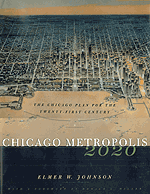 And finally, Elmer W. Johnson peers into the city’s future with Chicago Metropolis 2020: The Chicago Plan for the Twenty-First Century. A guide for those in all spheres of influence who are working to make cities economically and socially vigorous while addressing the greatest problems modern metropolises face, Chicago Metropolis 2020 addresses all facets of urban life, from public education to suburban sprawl, from transportation to social and economic segregation, with the expressed goal of continuing Chicago’s tradition of renewal and foresight. An ambitious and necessary plan for a major city at the turn of the century, it aims at nothing less than economic vibrancy, quality of life, and equity of opportunity.
And finally, Elmer W. Johnson peers into the city’s future with Chicago Metropolis 2020: The Chicago Plan for the Twenty-First Century. A guide for those in all spheres of influence who are working to make cities economically and socially vigorous while addressing the greatest problems modern metropolises face, Chicago Metropolis 2020 addresses all facets of urban life, from public education to suburban sprawl, from transportation to social and economic segregation, with the expressed goal of continuing Chicago’s tradition of renewal and foresight. An ambitious and necessary plan for a major city at the turn of the century, it aims at nothing less than economic vibrancy, quality of life, and equity of opportunity.
This list is by no means exhaustive, so check out our entire catalog of Chicago-related titles. Undoubtedly the IOC’s decision, whatever it is, will factor in a future book about our fair city. So watch this space for exciting developments!